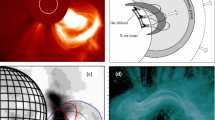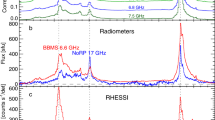Abstract
Evidence is discussed showing that a representative solar flare event comprises three or more separate but related phenomena requiring separate mechanisms. In particular it is possible to separate the most energetic effect (the interplanetary blast) from the thermal flare and from the rapid acceleration of particles to high energies. The phenomena are related through the magnetic structure characteristic of a composite flare event, being a bipolar surface field with most of its field lines ‘closed’. Of primary importance are helical twists on all scales, starting with the ‘flux rope’ of the spot pair which was fully twisted before it emerged. Subsequent untwisting by the upward propagation of an Alfvén twist wave provides the main flare energy.
-
(i)
The interplanetary blast model is based on subsurface, helically twisted flux ropes which erupt to form spots and then transfer their twists and energy by Alfvén-twist waves into the atmospheric magnetic fields. The blast is triggered by the prior-commencing flash phase or by a coronal wave.
-
(ii)
The thermal flare is explained in terms of Alfvén waves travelling up numerous ‘flux strands’ (Figure 3) which have frayed away from the two flux ropes. The waves originate in interaction (collisions, bending, twisting, rubbing) between subsurface flux strands; the sudden flash is caused by a collision. The classical twin-ribbon flare results from the collision of a flux rope with a tight bunch of S-shaped flux strands.
-
(iii)
The impulsive acceleration of electrons (hard X-ray, EUV, Hα and radio bursts) is tentatively attributed to magnetic reconnection between fields in two parallel, helically twisted flux strands in the low corona.
-
(iv)
Flare (Moreton) waves in the corona have the same origin as the interplanetary blast. Sympathetic flares represent only the start of enhanced activity in a flare event already in the slow phase. Filament activation also occurs during the slow phase as twist Alfvén waves store their energy in the atmosphere.
-
(v)
Flare ejecta are caused by Alfvén waves moving up flux strands. Surges are attributed to packets of twist Alfvén waves released into bundles of flux strands; the waves become non-linear and drive plasma upwards. Spray-type prominences result from accumulations of Alfvén wave energy in dome-shaped fields; excessive energy density eventually explodes the field.
Similar content being viewed by others
References
Alfvén, H. and Carlqvist, P.: 1967, Solar Phys. 1, 220.
Allen, C. W.: 1973, Astrophysical Quantities, Univ. London Press.
Altschuler, M. D., Lilliequist, C. G., and Nakagawa, Y.: 1968, Solar Phys. 5, 366.
Babcock, H. W.: 1961, Astrophys. J. 133, 572.
Barnes, C. W. and Sturrock, P. A.: 1972, Astrophys. J. 174, 659.
Brown, J. C.: 1973, Solar Phys. 31, 143.
Bruzek, A.: 1967, in J. H. Xanthakis (ed.), Solar Physics, Wiley-Interscience, New York, p. 399.
Bruzek, A.: 1969, in C. de Jager and Z. Švestka (eds.), Solar Flares and Space Research, North-Holland, Amsterdam, p. 61.
Bruzek, A. and Demastus, H. L.: 1970, Solar Phys. 12, 447.
Bumba, V.: 1962, Bull. Astron. Inst. Czech. 13, 48.
Carmichael, H.: 1964, in W. N. Hess (ed.), The Physics of Solar Flares, NASA Symp., p. 451.
de Jager, C.: 1969, in C. de Jager and Z. Švestka (eds.), Solar Flares and Space Research, North-Holland, Amsterdam, p. 1.
Ellison, M. A.: 1959, Monthly Notices Roy. Astron. Soc. 109, 3.
Frazier, E. N.: 1972, Solar Phys. 26, 130.
Gold, T.: 1964, in W. N. Hess (ed.), The Physics of Solar Flares, NASA Symp., p. 389.
Gold, T. and Hoyle, F.: 1960, Monthly Notices Roy. Astron. Soc. 120, 7.
Harvey, K. L.: 1971, Solar Phys. 16, 423.
Harvey, K. and Harvey, J.: 1973, Solar Phys. 28, 61.
Hyder, C. L.: 1968, in Y. Öhman (ed.), Nobel Symp. 9, 57.
Hyder, C. L., Epstein, G. L., and Hobbs, R. W.: 1973, Astrophys. J. 185, 985.
Hundhausen, A. J.: 1972, Coronal Expansion and Solar Wind, Springer-Verlag, Berlin.
Kane, S. R.: 1969, Astrophys. J. 157, L139.
Kane, S. R.: 1972, Solar Phys. 27, 174.
Kelley, P. T. and Rense, W. A.: 1972, Solar Phys. 26, 431.
Kiepenheuer, K. O.: 1964, in W. N. Hess (ed.), The Physics of Solar Flares, NASA Symp., p. 322.
Korobeinikov, V. P.: 1969, Solar Phys. 7, 463.
Lin, R. P.: 1974, Space Sci. Rev. 16, 189.
Michard, R.: 1971, in R. Howard (ed.), ‘Solar Magnetic Fields’, IAU Symp. 43, 359.
Moreton, G. E.: 1964, in W. N. Hess (ed.), The Physics of Solar Flares, NASA Symp., p. 209.
Mullan, D. J.: 1973, Astrophys. J. 185, 353.
Nakagawa, Y., Raadu, M. A., Billings, D. E., and McNamara, D.: 1971, Solar Phys. 19, 72.
Piddington, J. H.: 1969, Cosmic Electrodynamics, Wiley-Interscience, New York.
Piddington, J. H.: 1973a, Solar Phys. 31, 229.
Piddington, J. H.: 1973b, Solar Phys. 33, 363.
Piddington, J. H.: 1974, submitted to Solar Phys.
Pneuman, G. W.: 1967, Solar Phys. 2, 462.
Raadu, M. A. and Nakagawa, Y.: 1971, Solar Phys. 20, 64.
Richardson, R. S.: 1951, Astrophys. J. 114, 356.
Roy, J.-R.: 1973, Solar Phys. 32, 139.
Savage, B. D.: 1969, Astrophys. J. 156, 707.
Schmidt, H. U.: 1969, in C. de Jager and Z. Švestka (eds.), Solar Flares and Space Research, North- Holland, Amsterdam, p. 331.
Smith, D. F. and Priest, E. R.: 1972, Astrophys. J. 176, 487.
Smith, S. F. and Harvey, K. L.: 1971, in C. J. Macris (ed.), Physics of the Solar Corona, D. Reidel, Dordrecht-Holland, p. 156.
Smith, S. F. and Howard, R.: 1968, in K. O. Kiepenheuer (ed.), ‘Structure and Development of Solar Active Regions’, IAU Symp. 35, 33.
Stenflo, J. O.: 1969, Solar Phys. 8, 115.
Stenflo, J. O.: 1973, Solar Phys. 32, 41.
Sturrock, P. A.: 1972, Solar Phys. 23, 438.
Sturrock, P. A. and Coppi, B.: 1965, Astrophys. J. 143, 3.
Sweet, P. A.: 1969, Ann. Rev. Astron. Astrophys. 7, 149.
Švestka, Z.: 1969, in C. de Jager and Z. Švestka (eds.), Solar Flares and Space Research, North-Holland, Amsterdam, p. 16.
Švestka, Z.: 1970, Solar Phys. 13, 471.
Švestka, Z.: 1973, Solar Phys. 31, 389.
Syrovatskii, S. I.: 1972a, in E. Dyer (ed.), Solar Terrestrial Physics, Part I, D. Reidel, Dordrecht-Holland, p. 119.
Syrovatskii, S. I.: 1972b, Comm. Astrophys. Space Phys. 4, 65.
Uchida, Y.: 1974, paper in preparation.
Uchida, Y., Altschuler, M. D., and Newkirk, G.: 1973, Solar Phys. 28, 459.
Vorpahl, J. A.: 1972, Solar Phys. 26, 397.
Vrabec, D.: 1971, in R. Howard (ed.), ‘Solar Magnetic Fields’, IAU Symp. 43, 329.
Wentzel, D. G.: 1964, in W. N. Hess (ed.), The Physics of Solar Flares, NASA Symp., p. 397.
Westin, H.: 1969, Solar Phys. 7, 393.
Wild, J. P. and Smerd, S. F.: 1972, Ann. Rev. Astron. Astrophys. 10, 159.
Wilson, P. R.: 1972, Solar Phys. 22, 434.
Zirin, H. and Tanaka, K.: 1973, Solar Phys. 32, 173.
Author information
Authors and Affiliations
Rights and permissions
About this article
Cite this article
Piddington, J.H. The Alfvén-wave theory of solar flares. Sol Phys 38, 465–481 (1974). https://doi.org/10.1007/BF00155082
Received:
Issue Date:
DOI: https://doi.org/10.1007/BF00155082




